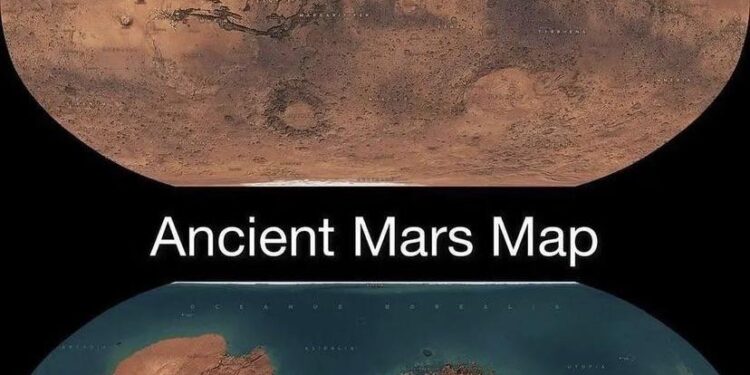In a groundbreaking development for planetary science, researchers have unveiled stunning new insights into the ancient environment of Mars, revealing tantalizing clues about the planet’s distant past. As scientists delve deeper into the Martian landscape, exploring its varied geology and atmospheric history, the findings suggest a once-lush world that may have harbored conditions favorable for life. This exploration, highlighted by recent data from missions like NASA’s Perseverance rover and the European Space Agency’s Mars Express, has sparked renewed interest in our neighboring planet, igniting debates about its potential for habitability and the mysteries that remain buried beneath its dusty surface. In this article, we will examine the latest discoveries, the technologies making them possible, and what they mean for both our understanding of Mars and the broader search for life beyond Earth.
Exploring the Geological Wonders of Ancient Mars for Clues to Terrestrial Life
The surface of ancient Mars has long captivated scientists, presenting a landscape that holds keys to understanding the potential for life beyond Earth. Recent missions, including data from the Perseverance rover, have provided a wealth of information about the planet’s geophysical features and chemical compositions. Researchers are focusing on myriad geological formations, such as ancient lakebeds, river deltas, and volcanic structures, which are believed to have harbored conditions suitable for life. Analyzing the mineralogy of these formations allows scientists to infer the climatic history of Mars, shedding light on periods when water was abundant, creating a more hospitable environment for biological activity.
Among the most intriguing aspects of this exploration is the search for biosignatures—evidence of past life preserved within Martian rock layers. The following are pivotal geological features currently under investigation:
- Jezero Crater: The ancient lake where the Perseverance rover landed; potential for fossilized microbial life.
- Gale Crater: Home to diverse sedimentary deposits that indicate historical water flow.
- Tharsis Volcanic Region: Suggests a rich geological history with implications for climate shifts.
To enhance our understanding, researchers have been examining the impact of solar radiation and atmospheric conditions on potential biosignatures. A comparison of terrestrial extremophiles—in organisms that thrive in harsh environments on Earth—offers clues about how life might have adapted to ancient Martian conditions. The table below illustrates key environmental factors influencing both Mars and Earth’s early biospheres:
| Factor | Mars Conditions | Earth Conditions |
|---|---|---|
| Atmospheric Composition | Thin CO2-rich atmosphere | Rich in O2 and N2 |
| Water Availability | Transient liquid water | Persistent liquid water bodies |
| Temperature Extremes | -125 to 20 °C | -88 to 58 °C |
Unraveling Mars Climate History to Understand Planetary Evolution
Recent studies are shedding light on the enigmatic climate history of Mars, revealing critical insights into its transformation over millions of years. Through a combination of orbital observations, satellite data, and surface geology analyses, scientists are piecing together a timeline that outlines the Red Planet’s evolution from a warm, wet environment—potentially conducive to life—to the cold, arid landscape we see today. Key findings suggest fluctuations in climate may have been influenced by factors such as axial tilt, solar radiation changes, and volcanic activity, making the study of Martian climate a window into understanding not just Mars itself but also broader planetary processes across the solar system.
The implications of these revelations are profound, not only for planetary science but also for astrobiology. By reconstructing ancient Martian climates, researchers hope to understand various planetary conditions that might support life. Comparing Mars to Earth, they identify similarities and differences, aiding in the development of models predicting planetary atmospheres. The table below summarizes recent findings that reflect Mars’ climatic shifts:
| Era | Climate Conditions | Key Features |
|---|---|---|
| 4.5 – 3.5 billion years ago | Warm and Wet | Presence of liquid water |
| 3.5 – 2.5 billion years ago | Cool and Dry | Formation of ice caps |
| 2.5 billion years ago – present | Cold and Arid | Thinning atmosphere |
Each era offers a glimpse into Mars’ dynamic history, showcasing shifts that resonate with theories of planetary evolution. As exploration continues, the integration of new technologies and data sets promises to deepen our understanding of Mars and its enduring mysteries. The echoes of its past climate may yet reveal clues about its potential to host life and its future in the context of ongoing celestial changes.
Recommendations for Future Missions to Unearth Mars Geological Secrets
As researchers continue to unlock the mysteries of Mars, future missions should prioritize specific objectives to deepen our understanding of the planet’s geological history. Targeting ancient lakebeds and river delta formations remains crucial, as these locations may hold vital clues about Mars’ past climate and potential habitability. Additionally, advanced robotic drilling technologies could help retrieve pristine samples from deeper layers of the Martian crust, providing a clearer picture of the planet’s evolutionary timeline. The inclusion of autonomous rovers equipped with sophisticated analytical tools can enhance real-time data acquisition, allowing scientists to make significant discoveries without lengthy delays in communication.
To maximize the impact of these missions, a collaborative approach involving international space agencies and research institutions is essential. Key recommendations include:
- Leveraging existing data: Utilizing findings from previous missions like Curiosity and Perseverance to identify high-priority sites.
- Investing in new technologies: Developing advanced sensors for in-situ analysis of Martian surface materials.
- Enhancing sample return missions: Building on the success of upcoming missions to ensure that high-value samples are brought back to Earth for analysis.
- Promoting public engagement: Involving citizen scientists in data collection and analysis, fostering a global interest in Martian exploration.
Concluding Remarks
As researchers continue to unravel the mysteries of ancient Mars, each discovery brings us closer to understanding the planet’s past and its potential for supporting life. The findings from recent studies underscore the significant geological and chemical processes that have shaped Mars over millennia, offering tantalizing clues about its habitability. With ongoing missions and advancements in technology, scientists are hopeful that further investigations will illuminate even more aspects of the Red Planet’s history. As our exploration continues, the quest to catch glimpses of ancient Mars remains not just an academic endeavor but a profound journey into our cosmic neighborhood, prompting deeper questions about our own planet and the possibility of life beyond Earth. The future of Martian exploration is bright, and only time will tell what further secrets lie beneath the Martian surface. Stay tuned as we keep you updated on the latest developments in this exciting field of research.































